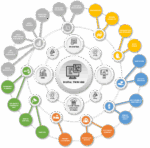
Buildings Are Getting More Complex — Can Construction Keep Up?
As the materials and technologies in modern buildings continue to advance, our design and construction methods have fallen behind the curve.
It may not be the world’s tallest man-made structure anymore, but New York City’s Empire State Building is still a go-to example of construction efficiency. The iconic skyscraper took just over 13 months to construct — a far cry from the seven years it took to complete New York’s most recent skyline-defining tower, One World Trade Center.
And while unavoidable logistical, regulatory, and safety considerations — not to mention its significantly larger size — played a major role in One World Trade Center’s extended timetable, the seven year mark nevertheless highlights an uncomfortable truth about modern construction: considerable improvements in areas like worksite safety and sustainability notwithstanding, the building process hasn’t substantively changed all that much over the past several decades.
I’m not suggesting that modern buildings are somehow structurally or materially identical to their early 20th century counterparts — in fact, the opposite is true. Thanks to continuous innovation in construction materials and in-building technologies, urban structures are becoming more and more advanced each year. The problem is that our buildings themselves have adapted to the times, but our design and construction methods have not.
Buildings Have Improved…
Consider, for example, one of the skyscraper’s most important features: elevators. The steel cords used to hoist elevators dozens of floors can only support so much weight, not to mention the fact that elevators can only travel so fast before the altitude change starts to have physical effects on riders’ bodies. Consequently, there exists a hard cap on the number of people per minute a typical building’s elevator system can transport.
In order to remove — or at least raise — this cap, ThyssenKrupp has developed a magnet-based, cord-free elevator system, Multi, capable of operating multiple cars within the same vertical shaft at once. By enabling its cars to move horizontally, Multi not only optimizes vertical shaft use, but also opens the door to radical new building designs incorporating more width than previously thought to be logistically prudent.
While ThyssenKrupp attempts to revolutionize how we travel through buildings, U.K.-based Materials for Life (M4L) is interested in ensuring that those buildings remain structurally sound over time. According to an M4L press release, the organization “is piloting three separate concrete-healing technologies for the first time in real-world settings, with a view to incorporating them into a single system that could be used to automatically repair concrete in the built environment.”
Dubbed “self-healing concrete,” M4L’s project embeds shape-memory polymers into traditional concrete that, when heated with a small energy current, fill the gaps and cracks that manifest in just about every structure over time.
…But Building Methods Have Not
Multi and self-healing concrete are just a few examples of hundreds of forward-thinking, game-changing architectural technologies either on the market or in advanced development. And yet, even when these technologies are incorporated into a new project, the project itself is still executed using the same methods and processes that have been around for years and years.
Zhang Yue, Chairman and CEO of China’s Broad Group, laments the AEC industry’s failure to embrace innovation. “In general,” he says, “the industry is underperforming. In many ways, we live in a very intelligent time. Yet there is still no precedent for a creative, low-emission, and practical approach to construction. From city planning to infrastructure development and building construction, from resource consumption to energy use, the industry is lagging behind the time in which we live.”
When we juxtapose the “what” — Multi, self-healing concrete, LEED certification — and the “how” — design and construction practices not that far removed from those used to erect the Empire State Building — it becomes clear that there is a lot of work to be done on the latter front. As Zhang continues, “I think this is largely due to mind-sets and that humans must change.” He’s absolutely right.
For example, virtual, augmented, and mixed reality tools facilitate interactive design and construction environments, diminishing project risk and increasing efficiency. Or there’s building information modeling (VIATechnik provides BIM services), which not only allows for complex 3D modeling, but also increased information sharing and collaboration across the board. The point is, the tools the AEC industry needs to move forward already exist — we just need to reach out and grab them.



